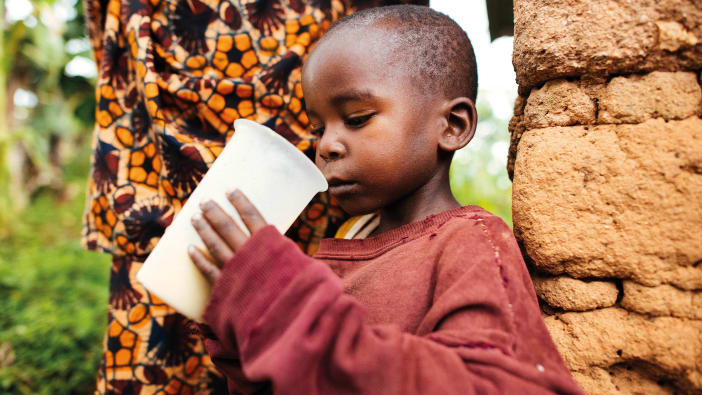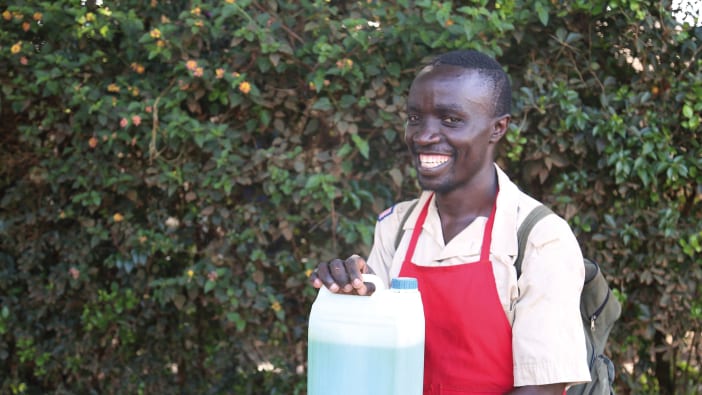The Child-to Child programme aims to help children to help each other. Children can be helped to discover the world in which they live and to realise that they are a group with a definite role to play in the community. The Child-to Child Trust provides teaching materials and ideas which encourage children and their teachers to learn about health living, through the use of questionnaires, discussions, stories and games. Together the children are encouraged to carry out practical projects, such as preventing accidents, or making toys, in their schools, homes and communities. There are now Child-to-Child projects in over 70 countries around the world.
Rachel Carnegie, Programme Officer for the Child-to-Child Trust, shares news of what children in Nigeria are doing to improve their communities:
“That little guinea worm is far too cruel,
The children won’t be able to go to school.
Listen to this song, now, and you will know,
How to make that guinea worm go!”
Salome and her friends, from the village of Ngarabe in eastern Nigeria, say that this is their favourite song. The children sing this song wherever they go and especially when they go to the village pond. For the village pond is the scheme of their battle with the guinea worm.
Guinea worm is one of the main health problems in this area. Children and adults alike suffer from the painful ulcers on the leg caused by this worm.
At school the children learnt from their teacher about how the guinea worm eggs come out of these leg ulcers when a person walks in water. The children went down to the village pond and watched. And, indeed, everybody did stand in the pond to collect the water. They then understood how the guinea worm had spread to so many people in their village, as they drank the eggs in this infected water.
The children and their teacher decided it was time for Child-to-Child action. They knew how to stop the guinea worm but they couldn’t do it alone. They started their campaign by composing the guinea worm song. Another verse goes:
“Don’t step in the water when you go to collect.
Bring it home, but you’re not finished yet!
Pour it through a filter, into a drinking pot,
Then the guinea worm is sure to be caught.”
With the catchy beat and tune of the song, soon everyone in the village was humming and tapping their feet, but the children still needed the cooperation of the adults if the health messages in their song were to become the accepted practice of the community. Their teacher and the village health worker called a meeting of the community, The children sang their song and performed a very entertaining play, showing how the guinea worm is spread. At the end of the play the children stood up before the audience and asked:
“How can we work together to stop the guinea worm?”
Suggestions came in from many sides. The health worker guided the discussion and, finally, the community decided on two courses of action.
First, the four village tailors offered to make a simple water filter for every household. These filters are made by stitching together two pieces of finely woven cloth.
Secondly, the village mason agreed to construct steps down to the village pond. He needed the children’s help in collecting stones for the steps. This village chief reminded everyone to stand on the last dry step when they were collecting water.
Now it is all action in the village. The tailors have finished sewing the cloth filters. Like all the school children, Salome has taken five filters: one for her own family and four for the neighbouring families. Salome said: “I show them how to pour their drinking water through the filter and tell them again about the guinea worm campaign. One child who doesn’t go to school wants to learn the words of the guinea worm song, so I am teaching him.”
The children have also spent each day after school collecting stones to use in making the steps by the pond. The guinea worm song has kept them happy in their task.
And so the campaign continues. Over the next months, the children will regularly monitor whether the preventive practices are being followed by all the village. If necessary, they will plan some other Child-to-Child activities to reinforce the messages and make sure that they “get that worm”!
The idea of Child-to-Child was introduced to Ngarabe by the primary school teacher. Now everyone in the village – from the health workers and the village leaders to the parents and the children themselves – believes in the idea. They are all convinced that children can take an active role in promoting health in their communities.
And the next Child-to-Child campaign? The teachers and health workers realise that there are so many ways in which children can play an active part in community life. For example, they could learn, and teach others, about oral rehydration or how to recognise the signs of pneumonia. But their activities need not be limited to health alone. The magic of Child-to-Child is the enthusiasm of children. Children enjoy taking an active part in many aspects of life in the family and community.








